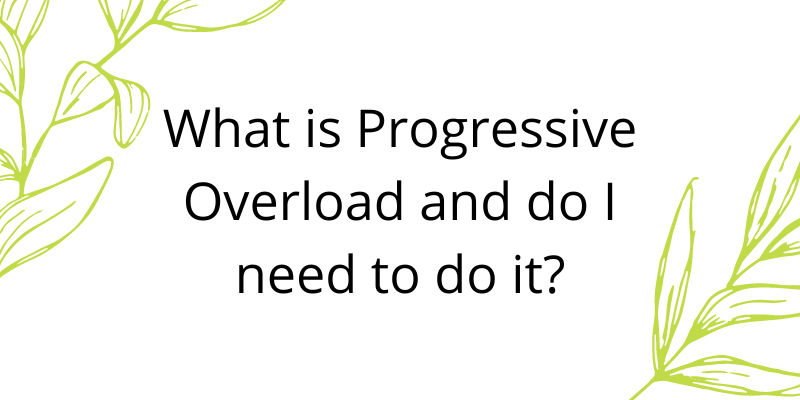Understanding Progressive Overload
Our bodies are very clever and will adapt to exercise very well. The more we do an exercise, the easier and less challenging it becomes. Keeping the weight the same (when the exercise starts to get easier) will mean that your strength and muscle mass will plateau because the muscles are not being stressed enough for them to strengthen and grow. Progressive overload is a core principle in the world of fitness and strength training and the most effective way for muscle growth and strength. This is important if you are looking to keep improving your strength, endurance or muscle mass. Understanding and applying progressive overload can significantly improve your workout results.
What is progressive overload?
Progressive overload is the principle of gradually increasing the intensity, duration or number of sets to challenge the muscles beyond what they are used to, which in turn stimulates growth and adaptation.
So, to get stronger, faster or fitter, you need to continually increase the demands on your body. This can be achieved through various methods such as lifting heavier weights/increasing the resistance of a machine, increasing the number of reps or sets, or reducing the rest time between sets.
When you work out, you create micro-tears in the muscle fibres which your body repairs during your rest and recovery, making the muscles stronger and more resilient. Progressive overload ensures that your body continues to adapt by progressively making the exercise more challenging. Without this increase in workload, your muscles would adapt to the current level of stress, and your progress will plateau. Progressive overload forces your body to adapt continuously, leading to improved strength, muscle mass and overall fitness.
Examples of how to incorporate progressive overload into your workout.
- Slowly increase the weight/resistance that you are using. One of the simplest ways to apply progressive overload is by adding more weight/resistance to your exercises. Start with a weight/resistance that allows you to complete your target number of reps with good form but still challenges you. When you can complete your reps and feel like you could comfortably do more, increase the weight slightly. Make sure that you are maintaining proper form when increasing the weight.
- Increase the reps or sets. If you are not able to increase the weight or resistance for any reason, then increasing the number of reps or sets that you are currently doing is a good way to execute progressive overload, eg. if you are doing 3 sets of 10 reps, then try increasing to 4 sets of 10 reps or 3 sets of 12 reps. Or if you are completing an exercise to time and manage 12 reps in that time, try increasing your speed to hit 14 reps in the same time frame. This also works well alongside increasing the weight/resistance. Start with 6 reps of a certain weight/resistance and when you can comfortably do 10 reps, increase the weight/resistance and start back at 6 reps building up to 10 again.
- Decrease rest time. Reducing the amount of rest between sets can make the exercise more challenging as this keeps your muscles under tension for a longer time, promoting muscle growth and endurance. Another way to do this is to hold or pulse during the exercise.
- Mix up the exercises. Introducing new exercises that target the same muscle groups can prevent the body from getting too used to a particular movement. This is a great way to stimulate further growth and adaptation.
- Increase frequency. Working out more often can also be a form of progressive overload, if adequate recovery time is maintained. Adding an extra training day for a specific muscle group can help to boost progress. Be mindful not to over exercise one particular muscle group, so mis it up with other exercise and rest days.
Common mistakes and how to avoid them.
- Increasing the weight too quickly. This can lead to injuries. Progressive overload should be gradual and steady to ensure safe and effective progress, and to maintain correct technique.
- Skipping rest days. Your muscles need time to repair and grow stronger after being stressed. Overtraining can lead to burnout and injuries. Make sure that you are getting enough rest and sleep and that you are incorporating active recovery into your routine. Active recovery is engaging in low intensity exercises on the days after an intense workout. This could be something like walking, cycling, Pilates, or yoga.
- Overlooking the importance of good nutrition. Proper nutrition is essential for muscle recovery and growth. Make sure that you are having enough protein, carbohydrates and healthy fats to support your training.
The long-term benefits of progressive overload.
Implementing progressive overload not only increases muscle growth and strength but also improves cardiovascular fitness, bone density, and metabolic rate. It helps to prevent injuries by strengthening muscles, tendons, and ligaments. It also boosts the sense of accomplishment as well as your mental well-being and motivation. Make sure to stick to the same programme in order to get the benefits of progressive overload – you won’t be able to do this if you change the exercises too often.
In simple terms, progressive overload is about striving for continuous, consistent improvement. By gradually increasing the demands on your body, whether that’s by increasing weight, reps or reducing rest time, you ensure consistent progress, and this leads to better health, fitness, and overall well-being. Remember, the key is to challenge yourself and be consistent, but always listen to your body and allow for adequate recovery.
Come and see us at W Fitness to see how we can help you with your fitness journey. Using our 30-minute circuit helps to build strength and muscle mass and as we do a review every month, the reps and resistance are increased to keep your muscles burning :)
Much Love
Caroline & Hannah xx
